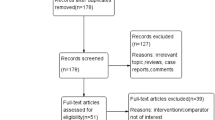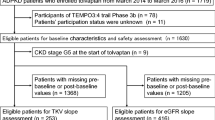Abstract
Purpose
Mammalian target of rapamycin (mTOR) inhibitors were previously considered a potential therapy for autosomal dominant polycystic kidney disease (ADPKD), but prior studies remained controversial about their efficacy. We performed an updated meta-analysis regarding the therapeutic and adverse effects of mTOR inhibitors in patients with ADPKD.
Methods
We systematically searched Cochrane Library, PubMed, EMBASE, and Medline for randomized controlled trials (RCTs) comparing mTOR inhibitors to placebo in ADPKD patients up to August 2019. We calculated weighted mean differences (WMDs) for total kidney volume (TKV), estimated glomerular filtration rates (eGFRs), and weighted odds ratios (ORs) for treatment-related complications between the treatment and the placebo groups, using the random effects model.
Results
We retrieved a total of 9 RCTs enrolling 784 ADPKD patients receiving rapamycin, sirolimus, or everolimus between 2009 and 2016. The WMDs of TKV and eGFR from baseline to the last measurement were − 31.54 mL (95% confidence interval [CI] − 76.79 to 13.71 mL) and 2.81 mL/min/1.73 m2 (95% CI − 1.85 to 7.46 mL/min/1.73 m2), respectively. Patients receiving mTOR inhibitors had a significantly increased risk of any adverse effects (OR 5.92, 95% CI 3.53–9.94), with the most common ones being aphthous stomatitis (OR 15.45, 95% CI 9.68–24.66) and peripheral edema (OR 3.49, 95% CI 1.31–9.27) compared to placebo users.
Conclusions
mTOR inhibitors did not significantly influence renal progression in patients with ADPKD, but were associated with a higher risk of complications. Whether mTOR inhibitors can be an add-on option or second-line agents remain undetermined.




Similar content being viewed by others
Data availability
The datasets generated during and/or analyzed during the current study are not publicly available but are available from the corresponding author on reasonable request.
References
Davies F, Coles GA, Harper PS, Williams AJ, Evans C, Cochlin D (1991) Polycystic kidney disease re-evaluated: a population-based study. Q J Med 79:477–485
Porath B, Gainullin VG, Cornec-Le Gall E, Dillinger EK, Heyer CM, Hopp K, Edwards ME, Madsen CD, Mauritz SR, Banks CJ, Baheti S et al (2016) Mutations in GANAB, encoding the glucosidase Iialpha subunit, cause autosomal-dominant polycystic kidney and liver disease. Am J Hum Genet 98:1193–1207
Lanktree MB, Chapman AB (2017) New treatment paradigms for ADPKD: moving towards precision medicine. Nat Rev Nephrol 13:750–768
Kanaan N, Devuyst O, Pirson Y (2014) Renal transplantation in autosomal dominant polycystic kidney disease. Nat Rev Nephrol 10:455–465
Jankowska M, Kuzmiuk-Glembin I, Skonieczny P, Debska-Slizien A (2018) Native nephrectomy in renal transplant recipients with autosomal dominant polycystic kidney disease. Transplant Proc 50:1863–1867
Gabow PA (1993) Autosomal dominant polycystic kidney disease. N Engl J Med 329:332–342
Ong AC, Devuyst O, Knebelmann B, Walz G (2015) Autosomal dominant polycystic kidney disease: the changing face of clinical management. Lancet 385:1993–2002
Novalic Z, van der Wal AM, Leonhard WN, Koehl G, Breuning MH, Geissler EK, de Heer E, Peters DJ (2012) Dose-dependent effects of sirolimus on mTOR signaling and polycystic kidney disease. J Am Soc Nephrol 23:842–853
Wu M, Wahl PR, Le Hir M, Wackerle-Men Y, Wuthrich RP, Serra AL (2007) Everolimus retards cyst growth and preserves kidney function in a rodent model for polycystic kidney disease. Kidney Blood Press Res 30:253–259
Chapman AB, Bost JE, Torres VE, Guay-Woodford L, Bae KT, Landsittel D, Li J, King BF, Martin D, Wetzel LH, Lockhart ME, Harris PC, Moxey-Mims M, Flessner M, Bennett WM, Grantham JJ (2012) Kidney volume and functional outcomes in autosomal dominant polycystic kidney disease. Clin J Am Soc Nephrol 7:479–486
Myint TM, Rangan GK, Webster AC (2014) Treatments to slow progression of autosomal dominant polycystic kidney disease: systematic review and meta-analysis of randomized trials. Nephrology 19:217–226
Xue C, Dai B, Mei C (2013) Long-term treatment with mammalian target of rapamycin inhibitor does not benefit patients with autosomal dominant polycystic kidney disease: a meta-analysis. Nephron Clin Pract 124:10–16
Braun WE, Schold JD, Stephany BR, Spirko RA, Herts BR (2014) Low-dose rapamycin (sirolimus) effects in autosomal dominant polycystic kidney disease: an open-label randomized controlled pilot study. Clin J Am Soc Nephrol 9:881–888
Chrispijn M, Gevers TJ, Hol JC, Monshouwer R, Dekker HM, Drenth JP (2013) Everolimus does not further reduce polycystic liver volume when added to long acting octreotide: results from a randomized controlled trial. J Hepatol 59:153–159
Ruggenenti P, Gentile G, Perico N, Perna A, Barcella L, Trillini M, Cortinovis M, Ferrer Siles CP, Reyes Loaeza JA, Aparicio MC, Fasolini G, Gaspari F, Martinetti D, Carrara F, Rubis N, Prandini S, Caroli A, Sharma K, Antiga L, Remuzzi A, Remuzzi G (2016) Effect of sirolimus on disease progression in patients with autosomal dominant polycystic kidney disease and CKD stages 3b-4. Clin J Am Soc Nephrol 11:785–794
Perico N, Antiga L, Caroli A, Ruggenenti P, Fasolini G, Cafaro M, Ondei P, Rubis N, Diadei O, Gherardi G, Prandini S, Panozo A, Bravo RF, Carminati S, De Leon FR, Gaspari F, Cortinovis M, Motterlini N, Enelordache B, Remuzzi A, Remuzzi G (2010) Sirolimus therapy to halt the progression of ADPKD. J Am Soc Nephrol 21:1031–1040
Serra AL, Poster D, Kistler AD, Krauer F, Raina S, Young J, Rentsch KM, Spanaus KS, Senn O, Kristanto P, Scheffel H, Weishaupt D, Wuthrich RP (2010) Sirolimus and kidney growth in autosomal dominant polycystic kidney disease. N Engl J Med 363:820–829
Soliman A, Zamil S, Lofty A, Ismail E (2012) Sirolimus produced S-shaped effect on adult polycystic kidneys after 2-year treatment. Transplant Proc 44:2936–2939
Stallone G, Infante B, Grandaliano G, Bristogiannis C, Macarini L, Mezzopane D, Bruno F, Montemurno E, Schirinzi A, Sabbatini M, Pisani A, Tataranni T, Schena FP, Gesualdo L (2012) Rapamycin for treatment of type I autosomal dominant polycystic kidney disease (RAPYD-study): a randomized, controlled study. Nephrol Dial Transplant 27:3560–3567
Walz G, Budde K, Mannaa M, Nurnberger J, Wanner C, Sommerer C, Kunzendorf U, Banas B, Horl WH, Obermuller N, Arns W, Pavenstadt H, Gaedeke J, Buchert M, May C, Gschaidmeier H, Kramer S, Eckardt KU (2010) Everolimus in patients with autosomal dominant polycystic kidney disease. N Engl J Med 363:830–840
Serra AL, Kistler AD, Poster D, Krauer F, Senn O, Raina S, Pavik I, Rentsch K, Regeniter A, Weishaupt D, Wuthrich RP (2009) Safety and tolerability of sirolimus treatment in patients with autosomal dominant polycystic kidney disease. Nephrol Dial Transplant 24:3334–3342
Nguyen LS, Vautier M, Allenbach Y, Zahr N, Benveniste O, Funck-Brentano C, Salem J-E (2019) Sirolimus and mTOR inhibitors: a review of side effects and specific management in solid organ transplantation. Drug Saf 42:813–825
Bolignano D, Palmer SC, Ruospo M, Zoccali C, Craig JC, Strippoli GF (2015) Interventions for preventing the progression of autosomal dominant polycystic kidney disease. Cochrane Database Syst Rev 7:CD010294
de Stephanis L, Bonon A, Varani K, Lanza G, Gafa R, Pinton P, Pema M, Somlo S, Boletta A, Aguiari G (2017) Double inhibition of cAMP and mTOR signalling may potentiate the reduction of cell growth in ADPKD cells. Clin Exp Nephrol 21:203–211
Harris PC, Torres VE (2014) Genetic mechanisms and signaling pathways in autosomal dominant polycystic kidney disease. J Clin Invest 124:2315–2324
Willey CJ, Blais JD, Hall AK, Krasa HB, Makin AJ, Czerwiec FS (2017) Prevalence of autosomal dominant polycystic kidney disease in the European Union. Nephrol Dial Transplant 32:1356–1363
Fedeles SV, Gallagher AR, Somlo S (2014) Polycystin-1: a master regulator of intersecting cystic pathways. Trend Mol Med 20:251–260
Watnick TJ, Germino GG (2013) Polycystic kidney disease: polycystin-1 and polycystin-2—it’s complicated. Nat Rev Nephrol 9:249–250
Ong AC, Harris PC (2015) A polycystin-centric view of cyst formation and disease: the polycystins revisited. Kidney Int 88:699–710
Torres VE, Boletta A, Chapman A, Gattone V, Pei Y, Qian Q, Wallace DP, Weimbs T, Wuthrich RP (2010) Prospects for mTOR inhibitor use in patients with polycystic kidney disease and hamartomatous diseases. Clin J Am Soc Nephrol 5:1312–1329
Zhang H, Bajraszewski N, Wu E, Wang H, Moseman AP, Dabora SL, Griffin JD, Kwiatkowski DJ (2007) PDGFRs are critical for PI3K/Akt activation and negatively regulated by mTOR. J Clin Invest 117:730–738
Li A, Fan S, Xu Y, Meng J, Shen X, Mao J, Zhang L, Zhang X, Moeckel G, Wu D, Wu G, Liang C (2017) Rapamycin treatment dose-dependently improves the cystic kidney in a new ADPKD mouse model via the mTORC1 and cell-cycle-associated CDK1/cyclin axis. J Cell Mol Med 21:1619–1635
Qian Q, Du H, King BF, Kumar S, Dean PG, Cosio FG, Torres VE (2008) Sirolimus reduces polycystic liver volume in ADPKD patients. J Am Soc Nephrol 19:631–638
Funding
The study was financially sponsored by Taipei Medical University Shuang-Ho Hospital. The sponsors have no role in the study design, data collection, analysis, and result interpretation of this study.
Author information
Authors and Affiliations
Contributions
Study design: CHL, MYW, WCL; data analysis: CHL, WCL, TCL; article drafting: CHL, MYW, WCL, TCL, CTC; all authors approved the final version of the manuscript.
Corresponding author
Ethics declarations
Conflict of interest
The authors have no relevant financial or non-financial competing interests to declare in relation to this manuscript.
Additional information
Publisher's Note
Springer Nature remains neutral with regard to jurisdictional claims in published maps and institutional affiliations.
Electronic supplementary material
Below is the link to the electronic supplementary material.
Rights and permissions
About this article
Cite this article
Lin, CH., Chao, CT., Wu, MY. et al. Use of mammalian target of rapamycin inhibitors in patient with autosomal dominant polycystic kidney disease: an updated meta-analysis. Int Urol Nephrol 51, 2015–2025 (2019). https://doi.org/10.1007/s11255-019-02292-1
Received:
Accepted:
Published:
Issue Date:
DOI: https://doi.org/10.1007/s11255-019-02292-1




